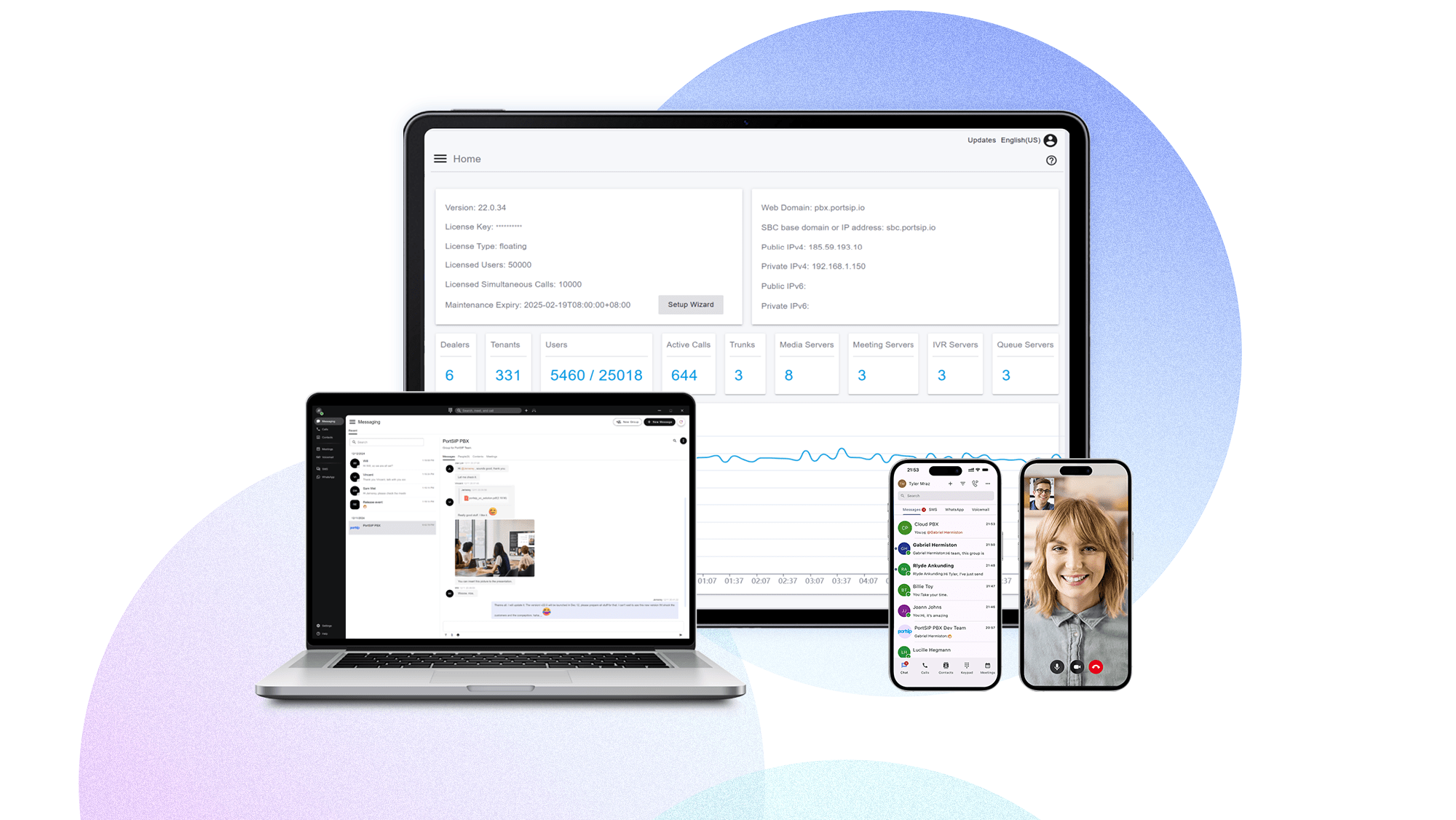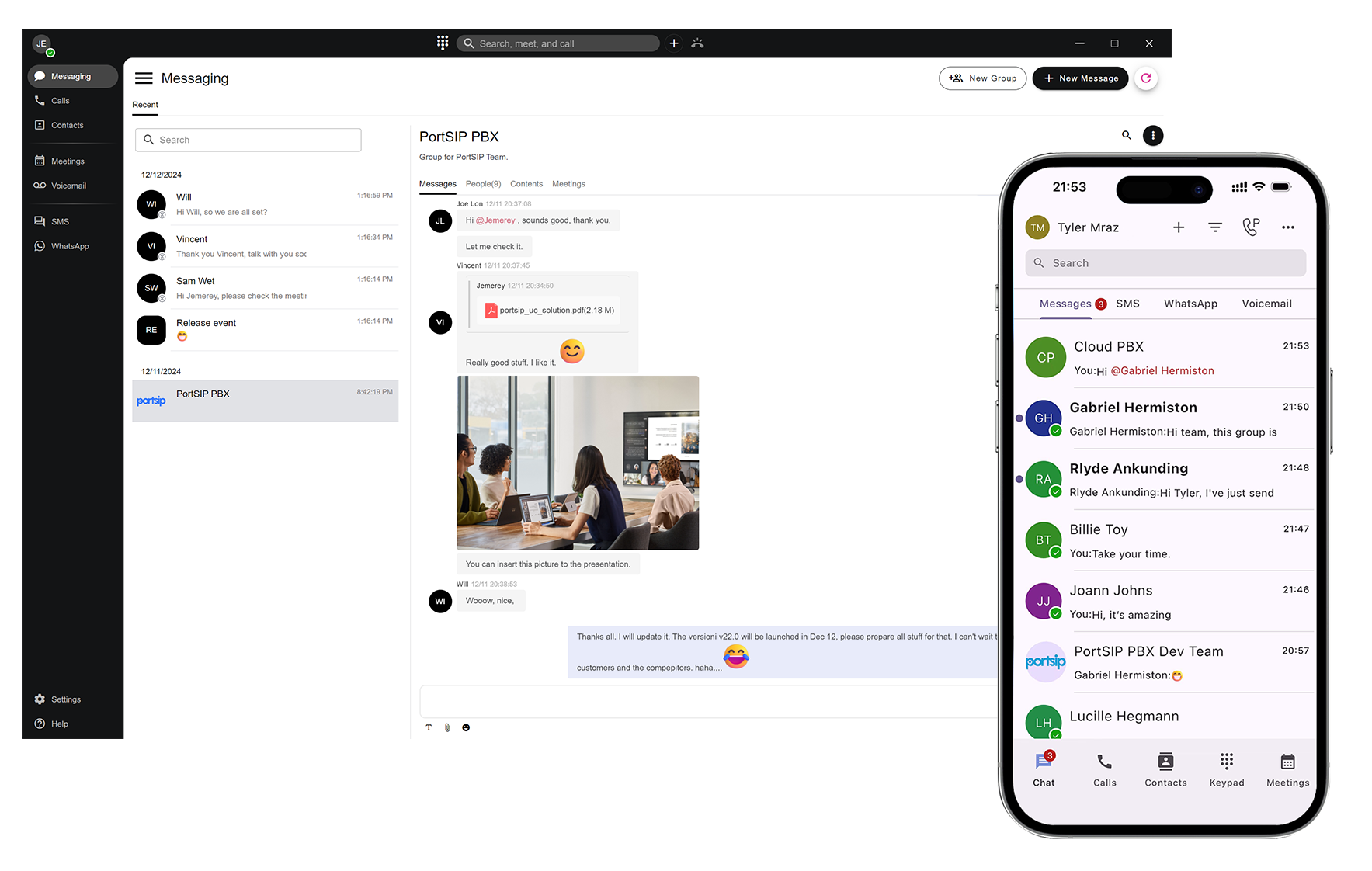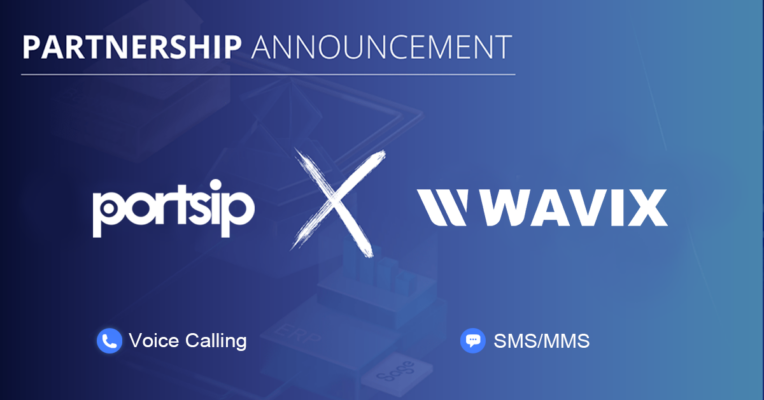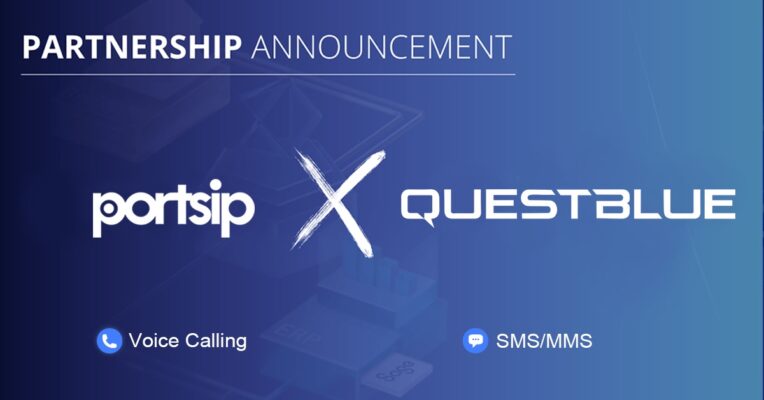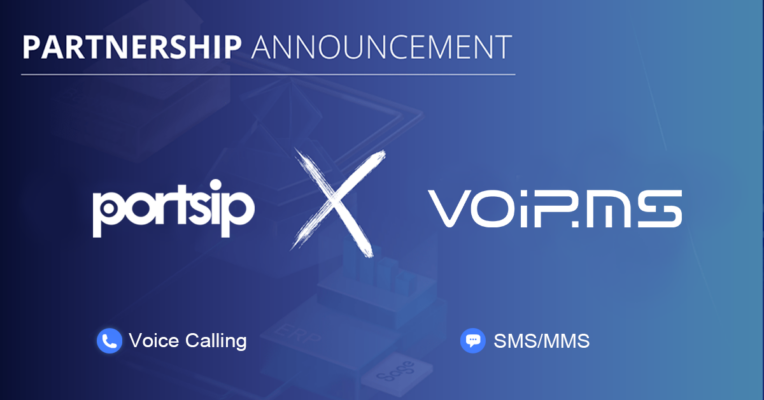The communication technology landscape is evolving rapidly, with cloud-based Unified Communications (UC) systems emerging as the preferred choice for businesses of all sizes. As traditional phone systems become increasingly obsolete, organizations are turning to more efficient and flexible communication solutions. Modern UC systems, with their scalability and adaptability, are particularly advantageous for companies embracing remote and hybrid work models, where seamless communication across various channels is essential.
When comparing PortSIP PBX with other PBX solutions for unified communications, the advantages of PortSIP become evident. Its unique features and capabilities clearly set it apart in the market.
In this article, we’ll explore why PortSIP PBX is the top choice for businesses looking to streamline their communication infrastructure.
All-in-one App for Modern Communications
The PortSIP ONE app provides a smooth, distraction-free experience, bringing the same seamless communication you enjoy at the office to any location. Connect with employees, teams, and customers around the world—keeping all your conversations in one place, no matter where you are.
Real Multi-Tenant PBX Designed for Cloud Age
Many vendors claim to provide multi-tenant PBXs, but most of their architecture is pseudo-multi-tenant. Typically, they need to install a new PBX instance for each tenant and then manage these instances through a centralized web portal. End-users are unaware of this, but for service providers, this is a significant issue:
-
- They need to maintain massive PBX instances.
-
- They waste server hardware resources.
For example, if a cloud PBX service provider has 1000 clients, each client is a tenant and needs to set up a PBX instance. Assume each tenant has about 10–50 extensions, and the server resources and maintenance work are unimaginable!
PortSIP PBX provides a real multi-tenant PBX for server providers to host the cloud PBX. Unlike other PBXs that require a separate PBX instance for each tenant, PortSIP PBX allows service providers to set up one instance and create thousands of tenants in that PBX instance. Each tenant can have its settings and extension numbers and is invisible to other tenants, the tenant feels he has a whole PBX. This excellent feature can save massive hardware resources and reduce maintenance work.

As shown in the screenshot above, the system administrator (service provider) or dealers (distributor, sub-distributor, reseller) can view and manage all tenants in the web portal. The following actions are available:
-
- Manage. Switch to manage the tenant’s extensions, call routings, settings, etc.
-
- Add. Create a new tenant.
-
- Edit. Change the settings of the tenant. For example, limit the capability of that tenant.
-
- Disable. Disable the tenant temporarily. All settings and data will be preserved and can be enabled again at any time.
-
- Delete. Delete the tenant from the PBX. All data of that tenant will be erased and can’t be recovered.
This is what modern multi-tenant PBX architecture is designed for in the cloud age. PortSIP has done an excellent job with this, and our clients are enjoying it a lot.
Full White-label Solution

Building your brand is never easy, but PortSIP can help you get there. Our rebranding feature allows you to fully private label your PBX and cloud PBX service and make it your own, including the following elements:
-
- Theme
-
- Product Name
-
- Company Name
-
- Website Link
-
- Logo Favicon
-
- User Agent string of PortSIP PBX and SBC
-
- WebRTC, Windows, and Mobile Apps
-
- IP Phone Templates
-
- Notification Email Templates
You just need to focus on the marketing, sales, and billing of your services, and we’ll take care of the rest! Please refer to the article Rebranding PortSIP PBX, SBC for more details.
A Scalable Communications Platform
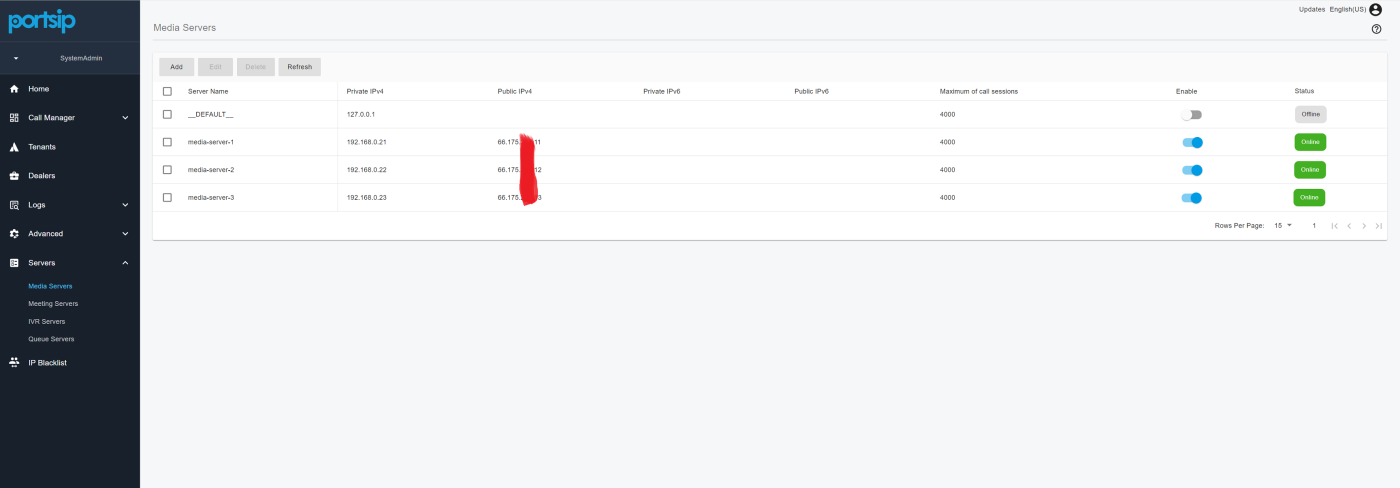
For cloud multi-tenant PBXs, the service provider hosts the PBX in the cloud and provides the calling service to users. Unlike single-tenant PBXs for SMBs, this means massive tenants and simultaneous calls are handled by the cloud PBX. The PBX vendor must take care of the performance.
PortSIP PBX is designed for the cloud age and offers high performance. It can handle massive extensions (users) and simultaneous calls. For large-size deployments, the PBX can extend the below servers for the cluster:
- Queue Server
- Meeting Server
- IVR Server
- Media server
- IM Server
With the extended servers cluster, the PBX Call Manager server only needs to process signaling. Utilizing multiple threads and cache technologies enables a PortSIP PBX instance to handle up to 100K users and 20K simultaneous calls. This is an impressive feat that meets most service providers’ scenarios.
As shown in the screenshot above, we disabled the default media server in the PBX server and extended three media servers to handle heavy calls.
Designed for High Performance
When designing a cloud PBX, every feature needs to be considered deeply, since it may cause performance issues when the amount of tenants and users is large.
For instance, for the call park feature, as per traditional PBX design, the PBX needs to create a dozen park spots for each tenant. In reality, these spots are PBX extensions that need to register with the PBX and refresh the registration period. The extensions also need to subscribe to these spot extensions for the dialog event to receive an alert when a call has been parked on the spot. Additionally, the extensions need to maintain their subscription by sending the SUBSCRIBE message periodically.
Assume each tenant creates 5 park spots, then for a cloud PBX with 1k tenants, there will need to be 5K park spots (extensions) created for the tenants. As mentioned above, these spots are PBX extensions. The registration and subscription of these spots will consume massive CPU, memory, and bandwidth resources and reduce cloud PBX performance. This is unacceptable for service providers. It’s hard to imagine if tenants need to create more park spots!
PortSIP pays attention to each feature for multi-tenancy. To avoid the problems of traditional PBXs, PortSIP has designed the call parking feature in a unique way that is easy to use and more friendly. It also has good performance and uses fewer resources. You can find more details in these articles:
Complete Contact Center Solution at no Extra Cost
PortSIP PBX Contact Center solution offers a powerful suite of features to streamline your operations and improve customer interactions. With dynamic call queues, detailed reporting, live wallboards, and integrations with SMS and WhatsApp, customers can reach you through their preferred channels, ensuring seamless communication.
Key Features Include:
- Skill-based Routing & Queue Strategies: Optimize call handling for better efficiency and customer satisfaction.
- Call-back Options: Never miss a call, and give customers the flexibility they need.
- Real-time Monitoring & Training Tools: With features like Listen In, Whisper, and Barge In, supervisors can maintain high service quality with continuous monitoring and real-time coaching.
- Live Wallboards: Display real-time data on call queues, agent performance, and more for better team visibility and performance tracking.
- SMS & WhatsApp Integration: Engage with customers on their preferred channels, providing fast and efficient communication.
- Last Called Agent: Automatically route calls back to the last agent who handled the customer, improving continuity and satisfaction.
- VIP Support: Prioritize calls from VIP customers, ensuring they receive immediate attention and a premium service experience.
- Exclusive Agent Features: Assign specific agents to handle exclusive customers or certain types of queries, ensuring personalized service and expertise.
- Analytics & Reporting: Gain actionable insights with in-depth analytics and customizable reports on call performance, agent productivity, and customer satisfaction metrics.
All of these powerful tools are available at no extra cost—helping you manage your contact center efficiently, without additional licensing fees.
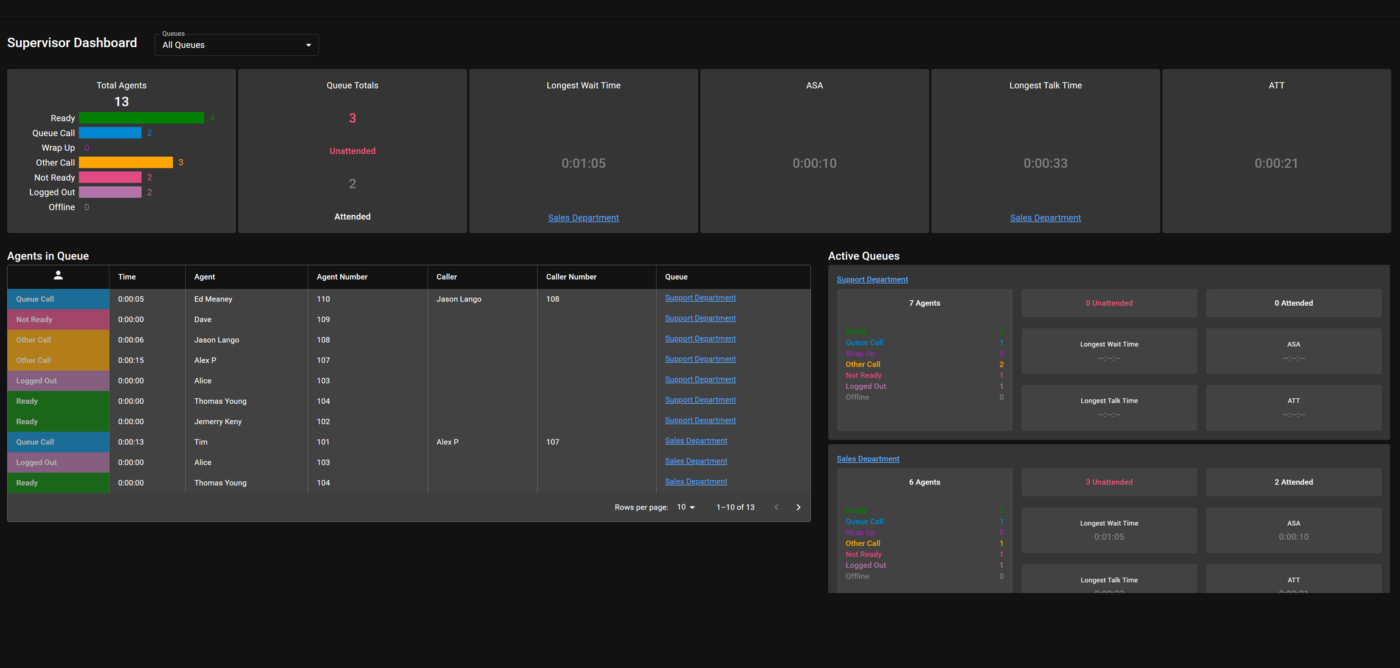
PortSIP Wallboard
Seamless Migration from BroadSoft

PortSIP PBX also offers rich features that are different from other PBX, a lot of the features are like the Broadsoft, for example, the Feature Access Codes (dial codes).
These PortSIP PBX feature access codes are mostly the same as Broadsoft and allow users to work more easily. Each tenant can customize its feature access code to meet their user experience needs. You can find more details in this article: Feature Access Codes.
Modern Unified Collaboration Solution
PortSIP PBX also offers a free comprehensive collaboration and communication solution for hybrid work, enabling inclusive experiences for everyone while protecting your data with industry-leading security. It provides calling, messaging, meetings, and sharing in a unified experience across web, desktop, and mobile apps, out of the box. All the ways to connect:
- Audio and Video Calling
- Audio and Video Meetings
- Messaging and Presence
- Audio Messaging
- Video Messaging
- Screen Sharing
- Presence Sync
- Contact Sync
- Group Chat
- File Sharing
- SMS
Digital Engagement Channels
PortSIP PBX integrates the SMS/WhatsApp Business API to help businesses elevate their customer interactions. With real-time, conversational messaging, businesses can drive personalized engagement across sales, marketing, and support, ensuring that each touchpoint enhances the customer experience.
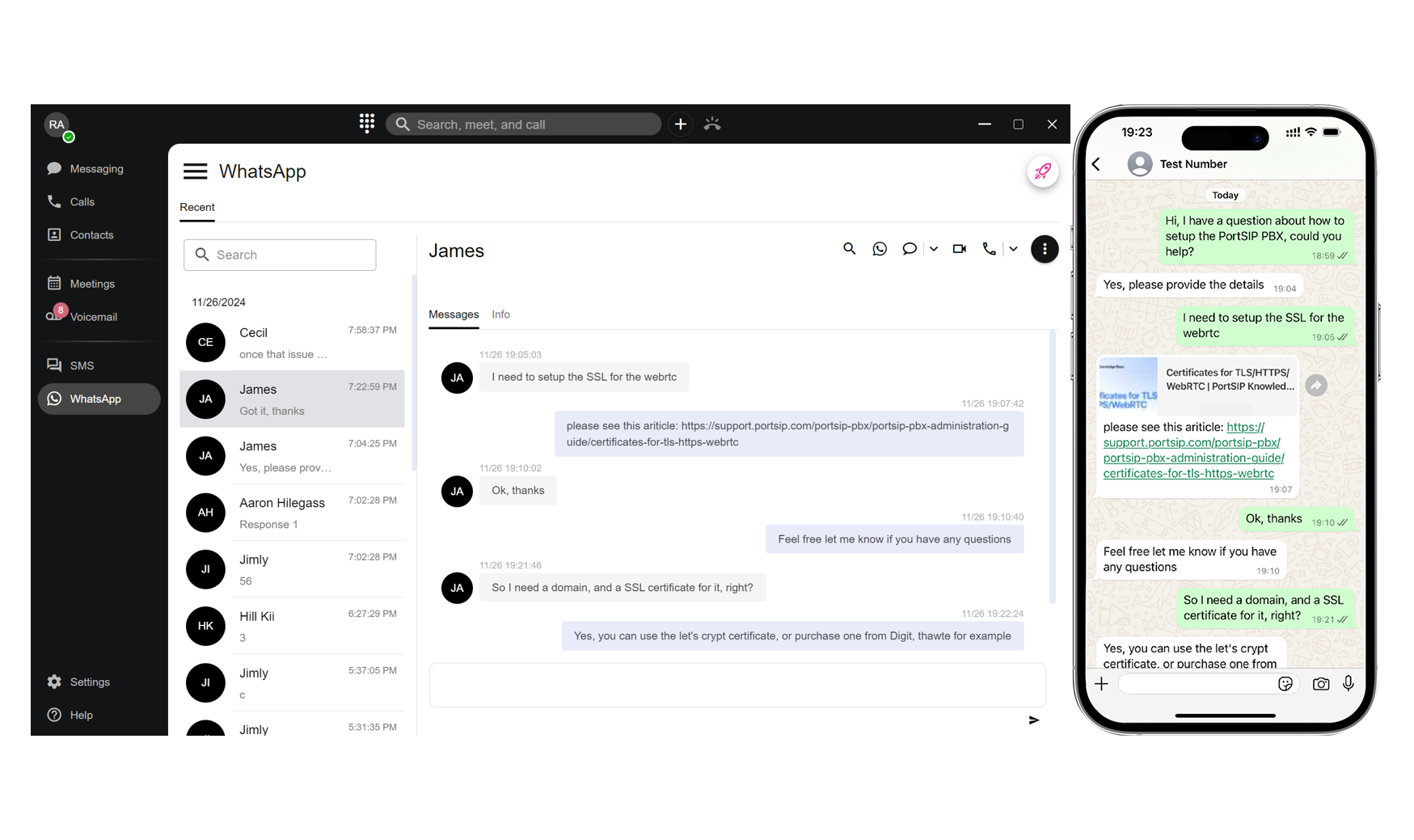
Effortless User Management
The tenant administrator can manage users easily through the user list in the PBX web portal, where all extension statuses are listed and indicate whether they are online/offline/on call/push notification enabled/automatic callback enabled/DND enabled.

You can click the search icon to view the device details for any online extension. In the example shown below, extension 103 is registered from both the PortSIP ONE app (IP address: 192.168.2.217, port: 5090 using UDP transport) and a Fanvil V65 IP phone (IP address: 192.168.2.36, port: 5060 using UDP transport). This detailed view enables administrators to easily monitor the devices connected to each extension.
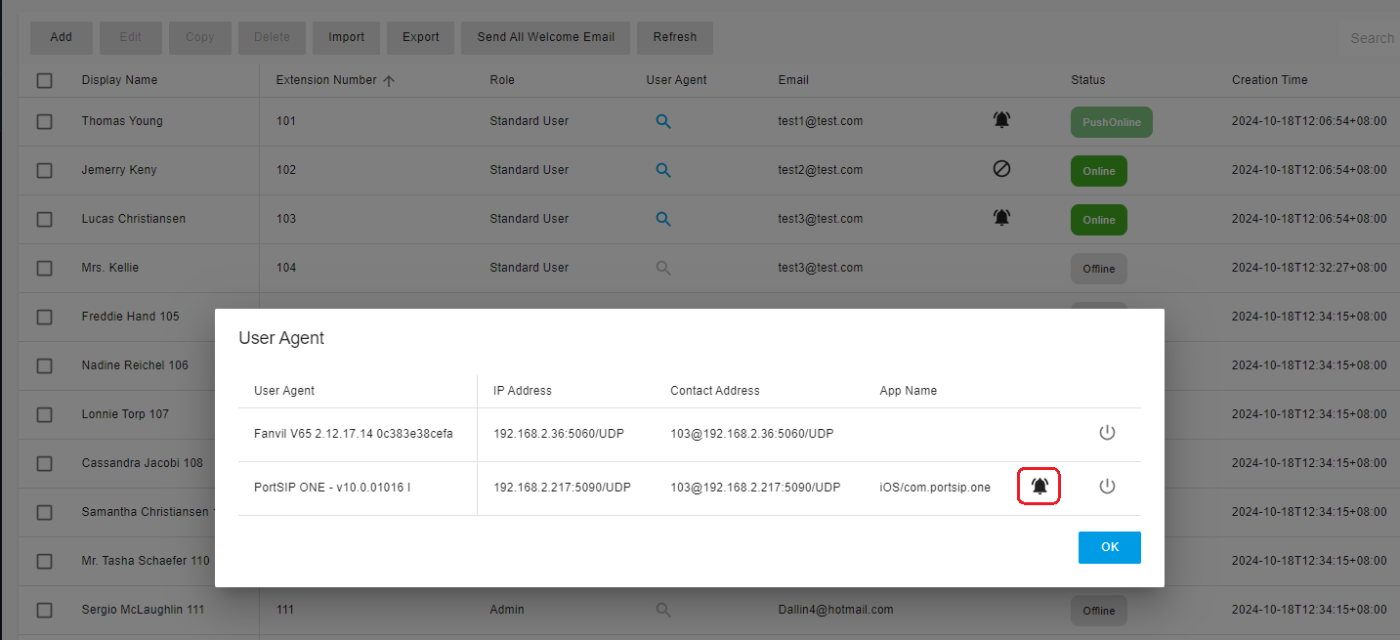
CDR and Recording
PortSIP PBX supports both audio and video recording and can record calls in MP3 or MP4 format, which makes it easy to play them in the browser.
The CDR is linked with the recording file, which can be downloaded and played in a browser.
The PortSIP CDR feature is different from other PBXs in that if a call is rerouted and forwarded multiple times during the call, the PBX will tie all call targets in one CDR. This makes it easy to track the call flow.


PortSIP PBX Recordings Management
For example, if a call comes from the SIP trunk and arrives at the PBX, then is routed to the IVR and re-routed to the queue by the user pressing DTMF, and an agent of the queue answers that call, all this information(callee number, callee IP address, and port) and timestamp are recorded in the CDR. For more details, please read this article: CDR and Call Recording.
Storing Into AWS S3
Privacy
PortSIP PBX also takes care of the privacy of the recording. Due to privacy and security concerns in some countries, the law stipulates that when a call is made between two external numbers, it should not be recorded.
Consider the following scenario: The client calls the contact center from the trunk and the agent answers. The call is starting to be recorded, and after a while of conversation, the agent transfers the client’s call to another landline/mobile phone number, the call is now between two PSTN phone numbers. At this point, the PBX should stop the call recording automatically. PortSIP provides an option for this feature, please read the details in this article: Automatically stop recording the call between two external numbers.
Security

Essentially, the cloud PBX phone system is a communication solution that enables your business to make and receive calls via the Internet, thereby rendering traditional landlines obsolete. However, like any cloud-based system, it introduces new security vulnerabilities, such as cyber-attacks and phishing scams.
PortSIP PBX places a high priority on security to keep your business safe. For instance, in PortSIP PBX, each extension’s IP Phone configuration file is stored in a distinct directory with a randomly generated long name. This prevents anyone from guessing the URL to download the configuration file, even if the phone’s MAC address is leaked. This approach sets PortSIP PBX apart from other PBX systems.
Please read the article PortSIP PBX Security Features for more details.
Trunk Management
Different cloud PBX providers have varying requirements due to their unique business models.
Some providers only host the cloud PBX and do not offer SIP trunks to tenants, requiring tenants to configure their own trunks.
Other service providers offer cloud PBX and SIP trunk bundles, limiting tenant configuration of trunks. In this case, all trunks must be configured by the service provider, who assigns a range of DID numbers (DID pool) to tenants. Tenants can only use the trunk and DID numbers assigned by the service provider to create call routing rules.
Some service providers offer a hybrid mode that allows tenants to configure their own trunks and use the trunks and DID numbers assigned by the service provider.
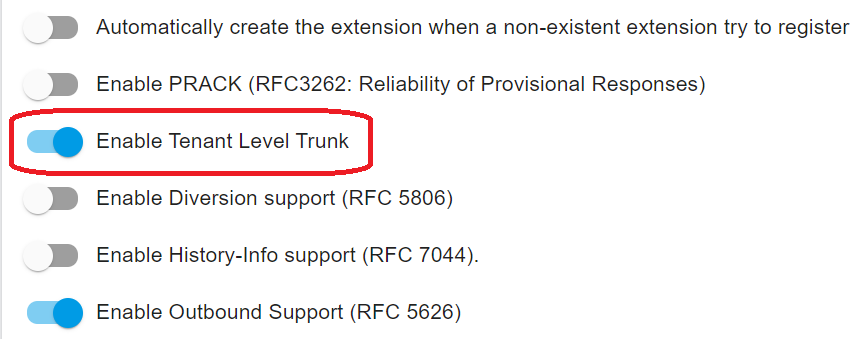
PortSIP PBX supports all requirements for service providers to meet their business models. An option called Enable Tenant Level Trunk allows service providers to enable or disable tenant trunk configuration.
Webhook
Pub/Sub
PortSIP PBX provides the Pub/Sub mechanism which is based on the WebSocket (PortSIP WSI).
The user is able to create the WebSocket in any programming language to subscribe to the PBX events, once the subscribed events occur, PortSIP PBX will send the event message to the subscriber automatically, the message is in the JSON format. For more details please read this article: WSI: Pub/Sub.
Dealers
The cloud PBX service providers just need to focus on hosting the PBX system in the cloud, ensuring service operation, and providing continuous stable service.
Distributors/Resellers partner with the service providers to give out cloud PBX services and products to the customers.
A distributor or the reseller purchases cloud PBX services and cloud-based PBX products from the cloud service provider and further sells them to the end users.
PortSIP PBX offers a great feature called Dealers for the above scenario that allows service providers to manage dealers (distributors and resellers) easily. For more details please read the article: Dealers.
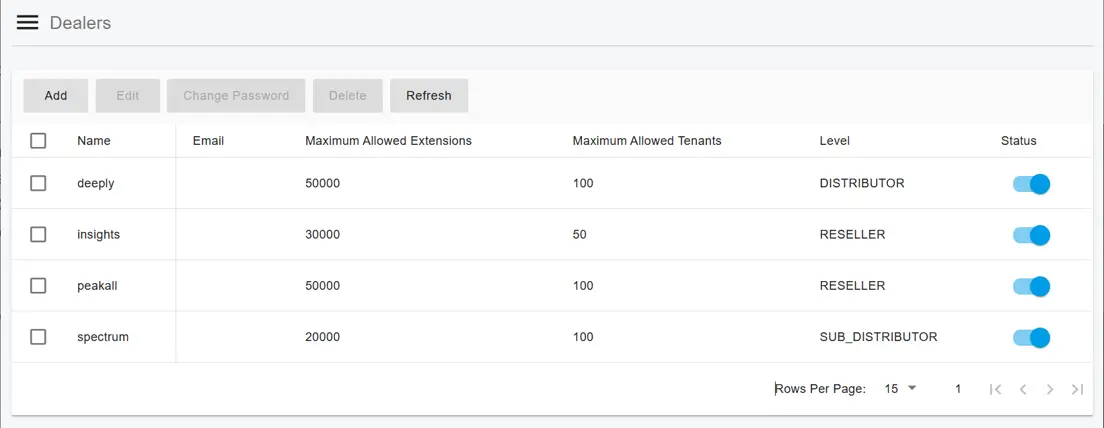
PortSIP PBX Dealers
Flexibility Office Hours and Holidays
Free SBC
PortSIP PBX offers a free SBC for secure deployment and also offers WebRTC and Microsoft Teams Direct Routing. The SBC can be deployed as a cluster to support large call volumes, those are totally free.
Microsoft 365 Integration
PortSIP PBX seamlessly integrates business communications into your cloud work environment, transforming Microsoft 365 into an enterprise-grade communications hub with a powerful and easy-to-use interface and SSO, that is simple for end-users to deploy and IT to manage.
For more details, please read this article: Microsoft 365 Integration.
Open REST API
Free PortSIP VoIP SDK for CPaaS
Push Notifications
A Voice over Internet Protocol (VoIP) app lets users make and receive phone calls by using an Internet connection instead of the device’s cellular service. Since the VoIP app relies heavily on the network, it’s not surprising that making calls usually results in high power consumption.
PortSIP PBX supports mobile push notifications for iOS and Android apps. All PortSIP users will benefit from this feature, for more details please read this article: Mobile push notifications.
Open API Solution with Flexible App Integrations
PortSIP offers a VoIP SDK for creating client apps, and REST API, Webhook, and Pub/Sub that can be used with PortSIP PBX to create modern unified communications apps for iOS, Android, Windows, macOS, and WebRTC. It allows the service provider to operate the CPaaS easily.
This award-winning SDK is used by many large companies such as T-Mobile, Nextiva, Qualcomm, Telstra, HPE, Siemens, Netflix, Agilent, and Dialogic: PortSIP VoIP SDK.
Rebranding App
PortSIP PBX has an app for the below OS:
-
- iOS
-
- Android
-
- Windows Desktop
-
- WebRTC
PortSIP PBX Solution Has Your Back

When weighing the solution for hosting the Cloud PBX, you have to look at your needs today and tomorrow. You have to ask yourself where you want to be in the next year or two and beyond.
Here at PortSIP, we’ll walk you through everything, including free porting of your existing solution. We’ll help you select the right VoIP desk phones that meet your client’s budget and everyday business needs.
In the age of the cloud, you cannot keep inching along with a legacy PBX. Your traditional PBX solution costs you more than it’s saving.
Take advantage of the PortSIP Solution and the freedom to work from anywhere. PortSIP PBX lets you focus on serving your customers, not trying to figure out the system. You can leave the rest to us.

